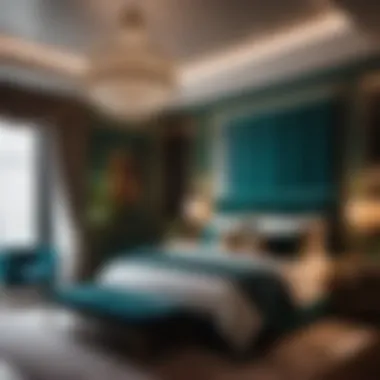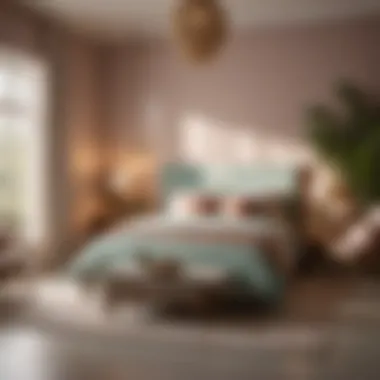Elevate Your Master Bedroom: A Guide to Choosing the Perfect Color Scheme


Materials:
- Paint: Choose high-quality paint in desired colors. Recommended amounts are 3 gallons for walls and 1 gallon for ceiling (exact color codes: [insert codes here]).
- Paintbrushes and rollers: Ensure varying sizes for precision and coverage.
- Painter's tape: Essential for clean edges and protection of surfaces.
- Drop cloths: Protect flooring and furniture from paint spills.
DIY Steps:
- Preparation: Clear the room of furniture and cover flooring with drop cloths. Clean walls and remove any imperfections.
- Color Selection: Consider the desired ambiance and personal preference. Test paint samples on the walls to observe how they look in different lighting conditions.
- Prime Walls: Apply a primer coat for better paint adhesion and coverage.
- Painting Walls: Begin with the corners and edges using a paintbrush, then use a roller for the main surface. Go for even strokes and apply a second coat for a professional finish.
- Ceiling Painting: Use a roller to paint the ceiling, working systematically for uniform coverage.
Technical Aspects:
- Tools: Paintbrushes, rollers, painter's tape, drop cloths, ladder.
- Timing: Allocate 2-3 days for the entire painting process, including drying time.
- Techniques: Cut in carefully along edges, use long strokes for walls, work in small sections for consistency.
DIY Project Process:
- Installation Method: Work from top to bottom, ensuring thorough coverage and blending of colors at edges.
- Key Techniques: Use a steady hand for precise lines, overlap strokes slightly for seamless results.
- Maintenace Tips: Store leftover paint for touch-ups, clean brushes and rollers thoroughly for reuse.
- Troubleshooting Tips: Smooth out drips with a brush, address uneven coverage by applying additional coats.
Understanding Color Theory
Color theory is a fundamental aspect when it comes to creating the perfect color scheme for your master bedroom. Understanding the principles of color theory goes beyond just picking colors that look nice together; it involves delving into the intricate relationships between colors, their psychological effects, and the overall mood they can create within a space. By comprehending color theory, homeowners can make informed choices that reflect their personal style and desired ambiance.
Basic Principles of Color Theory


Primary, Secondary, and Tertiary Colors
Primary colors, such as red, blue, and yellow, are the building blocks of all other colors, making them essential in any color scheme. Secondary colors result from mixing primary colors, while tertiary colors are created by combining a primary and a secondary color. Understanding the distinctions between these color categories allows for the creation of harmonious and visually engaging combinations in your bedroom decor.
Color Wheel and Its Significance
The color wheel is a visual representation of how colors relate to each other. It helps in identifying color schemes like complementary and analogous colors, aiding in the selection process for your bedroom palette. By utilizing the color wheel, homeowners can experiment with different combinations and understand the visual impact each color will have in the room.
Complementary and Analogous Colors
Complementary colors sit opposite each other on the color wheel, creating a striking contrast when used together. Analogous colors, on the other hand, are adjacent to each other and provide a more subtle, harmonious look. By exploring these color relationships, individuals can determine the right balance of vibrancy and cohesion in their master bedroom's color scheme.
Psychology of Colors
Color psychology delves into the emotional and cognitive effects that different colors can have on individuals. By understanding how colors can influence mood and behavior, homeowners can curate a bedroom environment that aligns with their intentions and desired atmosphere.
Emotional Impact of Different Colors
Colors evoke specific emotions; for instance, blue is calming, while red may energize a space. By incorporating colors based on their emotional impact, homeowners can create a bedroom that promotes relaxation, productivity, or intimacy, depending on their preferences.
Cultural Associations with Colors


Colors can also carry cultural significance and symbolism. Understanding these traditional associations allows individuals to infuse their bedroom decor with meaning and heritage, adding depth and personal connection to the space.
Choosing Colors Based on Desired Atmosphere
Selecting colors that align with the desired atmosphere of the bedroom is crucial. Soft pastels may foster a sense of tranquility, while bold tones inject drama and flair. By choosing colors that resonate with the intended atmosphere, homeowners can create a space that not only looks beautiful but also feels emotionally resonant and conducive to relaxation.
Factors to Consider
Considering the room size is essential as it helps in determining whether to opt for lighter or darker hues. In small rooms, lighter colors can create an illusion of space and airiness, while darker shades can add coziness but may make the room feel more cramped. On the other hand, large rooms can handle bolder and darker colors without feeling overwhelming, allowing for more experimentation with contrasting tones.
Natural light also influences color perception. Rooms with abundant natural light tend to showcase colors more vibrantly, while spaces with limited light may require brighter tones to compensate for the lack of natural illumination. Understanding how light interacts with colors is key to selecting a palette that will look consistent and appealing throughout the day.
The consideration of room size and natural light in the color selection process ensures that the chosen scheme enhances the space and aligns with both practical and aesthetic preferences.
Popular Color Schemes
Neutral Palette
Elegance of White and Beige:
The elegance of white and beige holds a special place in the realm of interior design, offering a timeless and sophisticated allure to any space. White signifies purity and spaciousness, making it an excellent choice for smaller rooms as it can create an illusion of more significant space. Beige, on the other hand, exudes warmth and tranquility, blending well with various decor styles. The neutral palette of white and beige provides a versatile backdrop that allows for easy incorporation of different accent colors and texture elements, making it a popular choice for those seeking a serene and elegant bedroom ambiance.


Sophistication of Greys:
Greys symbolize sophistication and modernity, adding a sense of depth and richness to a room. Light grey tones can brighten up a space while darker greys create a sense of coziness and intimacy. The versatility of grey allows for a wide range of styling options, from minimalist Scandinavian designs to chic industrial aesthetics. The sophistication of greys in a color scheme brings a balance of understated elegance and contemporary flair, making it a favored choice among those who appreciate a refined and polished bedroom setting.
Bold and Vibrant Colors
Incorporating Jewel Tones:
Jewel tones bring opulence and drama to a master bedroom, elevating the visual interest and creating a luxurious ambiance. Deep hues of emerald green, sapphire blue, and ruby red add a touch of glamour and exoticism to the space. Incorporating jewel tones in accents like throw pillows, curtains, or a statement piece of furniture can infuse vibrancy and personality into the room, making it a captivating retreat filled with richness and splendor.
Styling with Rich Earthy Hues:
Rich earthy hues such as terracotta, burnt orange, and forest green connect the master bedroom to nature, fostering a sense of grounding and tranquility. These colors evoke feelings of warmth and comfort, creating a cozy and welcoming environment. Whether used as a focal point or blended with neutrals, rich earthy hues bring a sense of the outdoors inside, allowing homeowners to immerse themselves in a sanctuary inspired by the beauty of the natural world.
Monochromatic Harmonies
Creating Depth with Shades and Tints:
Monochromatic harmonies play with various shades and tints of a single color, offering a sophisticated and harmonious color scheme for a master bedroom. By playing with light and dark variations of a primary color, homeowners can create a sense of depth and dimension in the room. Lighter shades provide an airy and spacious feel, while darker tones bring a sense of intimacy and coziness, allowing for a balanced and visually appealing aesthetic that enhances the overall mood and atmosphere of the space.
Playing with Light and Dark Tones:
The interplay between light and dark tones in a monochromatic color scheme adds visual interest and complexity to the master bedroom. By contrasting light and dark shades of the chosen color, homeowners can create a dynamic and immersive environment that plays on light reflection and shadow effects. Light tones can highlight architectural details and accentuate specific areas, while dark tones add a sense of sophistication and mystery, resulting in a beautifully layered and visually engaging space that showcases the adaptable nature of monochromatic harmonies.
Maintenance and Adaptability
Maintaining and adapting your chosen color scheme in your master bedroom is crucial for ensuring its longevity and relevance over time. By considering the practicality of cleaning and upkeep, you can preserve the integrity of your colors and surfaces, keeping your room looking fresh and inviting. Understanding how different materials and finishes respond to cleaning products and techniques helps you make informed decisions when selecting furnishings and decor. Prioritize materials that are easy to maintain and clean to minimize the effort required to keep your master bedroom looking its best.
Flexibility for future style changes is another key aspect to consider when implementing your chosen color scheme. While your current design preferences may guide your choices today, allowing for flexibility in your color scheme allows for effortless updates and transformations in the future. Selecting versatile colors that pair well with a range of styles and aesthetics gives you the freedom to reinvent your space without starting from scratch. By incorporating interchangeable decor elements and accessories, you can adapt your master bedroom to suit evolving trends and tastes, ensuring its relevance for years to come.







